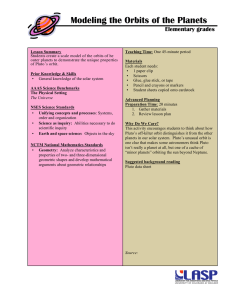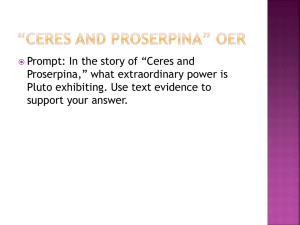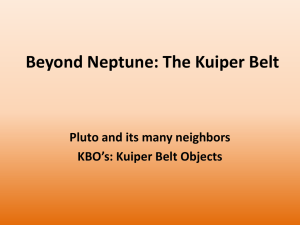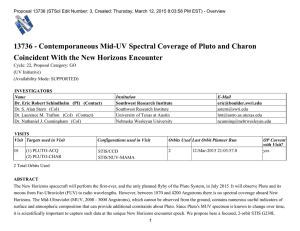Pluto & Charon Exploring Distant worlds
advertisement
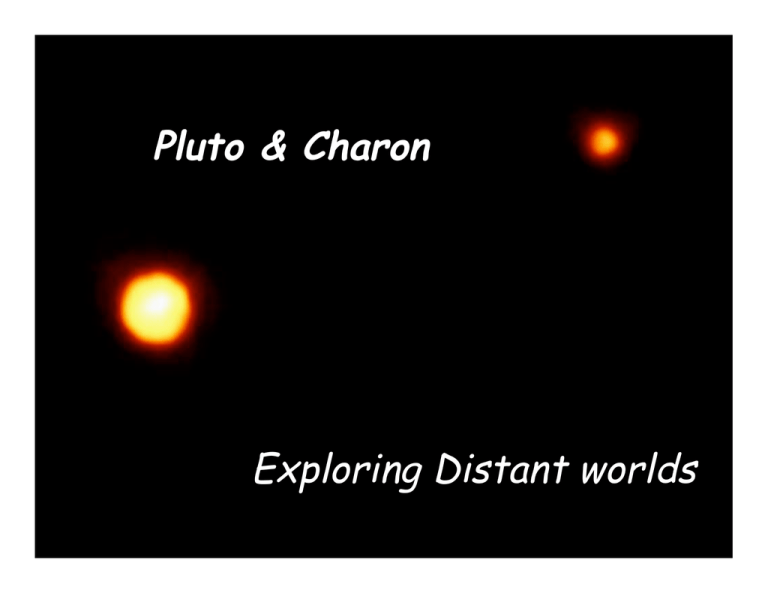
Pluto & Charon Exploring Distant worlds Pluto is just one of hundreds of objects in The Kuiper Belt the Hundreds of small icy worlds to explore - the keys to understanding the origin of our solar system Pluto was discovered in 1930 by Clyde Tombaugh at the Lowell Observatory, Arizona Tombaugh spent many nights at the telescope, many days looking at photographic plates looking for objects that move relative to the stars The Planets at a Glance Small Inner Rocky Planets Misfit Planets - Ice Dwarves Giant Outer Gas Planets Pluto orbits the Sun on an elliptical path, tilted from the plane of the planets, between 30 and 50 times the distance of the Earth from the Sun. In 1978 Jim Christy discovered that Pluto has a moon Charon Even with a good telescope, the Earth’s atmosphere makes tiny Pluto look very fuzzy Seeing is Understanding Pluto at Best HST Resolution Triton at Best HST Resolution Earth’s Moon at the Same Resolution HST = Hubble Space Telescope Hubble’s Best Pictures Smoothed and modeled images Temperature: 40 Kelvin -233 Celsius -340 F Surface = Ice + ... ??? 1988 Stellar occultation by Pluto Gradual decrease in starlight -> atmosphere Po~3 nanobar, T~50K The solar wind interacts with Pluto’s atmosphere like a comet Spectroscopy Reveals Composition Triton Voyager 2 1989 2 New Moons! Fall 2005 • Discovered with HST • Diameter ~100 km • Circular, resonant orbits You need a big antenna to send the data back from distant Pluto Camera New Horizons - Student Dust Counter Designed, Built, Tested, Operated, Analyzed by Students at CU SDC Detector Assembly Wiring Rail & Top Cover S/C Mounting Feet Detector Support Panel 37 Pin Intra-Harness Connector PVDF Detector 2005: Testing New Horizons Mission 2006 Launch Launch date: Jan 11-Feb 14, 2006 NH Star 48B S/C launch mass: 465 kg Pluto arrival: 2015-2020 Atlas V New Horizons to be launched on Atlas 551 with Star 48B upper stage from Cape Canaveral, Florida 2006 Baseline Mission Design Pluto-Charon Encounter Geometry – Arrival July 14, 2015 Charon-Earth Occultation 14:37:35 Pluto-Earth Occultation 13:10:44 Charon 14:00 Pluto 13:00 Charon-Sun Occultation 14:35:29 Sun Earth 0.24° Pluto-Sun Occultation 13:09:54 12:00 Charon C/A 12:33:47 26,673 km 13.87 km/s Pluto C/A 12:20:00 11,095 km 13.77 km/s New Horizons Mission Triton • Approach pictures better than Hubble for 150 days before arrival • Total cost ~$725 M over 10 years ~ 1 Starbucks coffee per taxpayer What will we see? Our best guess is that Pluto will be like Neptune’s moon Triton … or probably not?? The Kuiper Belt Neptune U S J >1000 Objects Discovered Since 1992 ..... and counting The Kuiper Belt • 1000s of objects - Ice (+ rock) • Dark (radiation? organics?) • 100 - 1000 miles across • Source of comets? • Boundary at 50 AU? • Scattered during outward migration of Neptune? ........ are there other, bigger planets out there? Planet X? Xena & Gabrielle - 10th Planet? All the more reason to get out there and explore! Let’s keep exploring! http://pluto.jhuapl.edu
